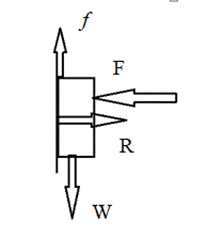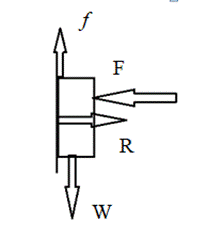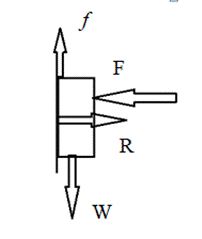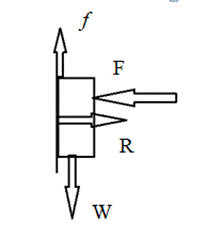
Concept explainers
(a)
The effect of weight of the book when reduce the applying force to the book in the same spot on the wall.
Answer to Problem 5QAP
The weight of the book is not changed.
Explanation of Solution
Introduction:
The book is pressed against on the wall. When we reduce the applying force to the book, the book remains in the same spot on the wall.

So the magnitude remains constant. Therefore weight stays the same.
Conclusion:
The weight stays the same.
(b)
The effect of the normal force of the wall on the book when reduce the applying force to the book in the same spot on the wall.
Answer to Problem 5QAP
The normal force of the wall on the book decreases.
Explanation of Solution
Introduction:
The book is pressed against on the wall. When we reduce the applying force to the book, the book remains in the same spot on the wall.

When applied force is reduced the normal force decreases.
Conclusion:
The normal force of the wall on the book decreases.
(c)
The effect of the frictional force of the wall on the book when reduce the applying force to the book in the same spot on the wall.
Answer to Problem 5QAP
The frictional force of the wall on the book is not changed.
Explanation of Solution
Introduction:
The book is pressed against on the wall. When we reduce the applying force to the book, the book remains in the same spot on the wall.

So the weight of the book is constant. Therefore the frictional force of the wall on the book stays same.
Conclusion:
The frictional force of the wall on the book stays same.
(d)
The effect of the maximum static frictional force of the wall on the book when reduce the applying force to the book in the same spot on the wall.
Answer to Problem 5QAP
The maximum static frictional force of the wall on the book deceases.
Explanation of Solution
Introduction:
The book is pressed against on the wall. When we reduce the applying force to the book, the book remains in the same spot on the wall.

When F reduces R decreases. Since
Conclusion:
The maximum static frictional force of the wall on the book deceases.
Want to see more full solutions like this?
Chapter 5 Solutions
COLLEGE PHYSICS
- For the woman being pulled forward on the toboggan in Figure 4.33, is the magnitude of the normal force exerted by the ground on the toboggan (a) equal to the total weight of the woman plus the toboggan, (b) greater than the total weight, (c) less than the total weight, or (d) possibly greater than or less than the total weight, depending on the size of the weight relative to the tension in the rope?arrow_forwardA block of ice (m = 15.0 kg) with an attached rope is at rest on a frictionless surface. You pull the block with a horizontal force of 95.0 N for 1.54 s. a. Determine the magnitude of each force acting on the block of ice while you are pulling. b. With what speed is the ice moving after you are finished pulling? Repeat Problem 71, but this time you pull on the block at an angle of 20.0.arrow_forwardTwo sheets of plywood A and B lie on the bed of the truck. They have the same weight W, and the coefficient of static friction between the two sheets of wood and between sheet B and the truck bed is µg. (a) If you apply a horizontal force to sheet A and apply no force sheet B to move? What force is necessary to cause sheet A to start to sheet B, can you slide sheet A off the truck without causing moving? (b) If you prevent sheet A from moving by exerting a horizontal force on it, what horizontal force on sheet B is necessary to start it moving? ܥܪ ܩ A B Larrow_forward
- If you press an apple crate against a wall so hard that the crate cannot slide down the wall, what is the direction of (a) the static frictional force on the crate from the wall and (b) the normal force on the crate from the wall? If you increase your push, what happens to (c) fs, (d) FN, and (e) fs,max?arrow_forwardA box filled with appliances rests on a floor. Only gravity and the support force of the floor act on it. When a slight pull P is exerted on the box but not enough to move it, the force of friction would be: A equal to P B less than P greater than P zeroarrow_forwardLet there be 2 blocks stacked on a table. The top block has a mass of 2.0 kg, and the bottom block has a mass of 5.0 kg. The coefficient of static friction between the two blocks is 0.40, and the coefficient of static friction between the bottom block and table is 0.10. What is the maximum horizontal force you can apply to the top block such that neither block moves?arrow_forward
- One block rests upon a horizontal surface. A second identical block rests upon the first one. The coefficient of static friction between the blocks is the same as the coefficient of static friction between the lower block and the horizontal surface. A horizontal force is applied to the upper block, and its magnitude is slowly increased. When the force reaches 40.4 N, the upper block just begins to slide. The force is then removed from the upper block, and the blocks are returned to their original configuration. What is the magnitude of the horizontal force that should be applied to the lower block, so that it just begins to slide out from under the upper block?arrow_forwardA block of wood weighing 4N is placed on a horizontal table. It is then pulled by means of a spring balance attached to one of it's ends. The block just begins to move when the spring balance records a horizontal force of 2.5N. 1) what is the coefficient of static friction? 2) what is the frictional force when a horizontal force of 2.0N is recorded by the spring balancearrow_forwardA vertical force f is applied to a block of mass m that lies on a floor.What happens to the magnitude of the normal force f on the block from the floor as magnitude F is increased from zero if force f is (a) downward and (b) upward?arrow_forward
- A woman exerts a constant horizontal force on a large box. As a result, the box moves across a horizontal floor at a constant speed "v0". The constant horizontal force applied by the woman: has the same magnitude as the weight of the box. is greater than the weight of the box. has the same magnitude as the total force which resists the motion of the box. is greater than the total force which resists the motion of the box. is greater than either the weight of the box or the total force which resists its motion. If the woman in the previous question doubles the constant horizontal force that she exerts on the box to push it on the same horizontal floor, the box then moves: with a constant speed that is double the speed "v0" in the previous question. with a constant speed that is greater than the speed "v0" in the previous question, but not necessarily twice as great. for a while with a speed that is constant and greater than the speed "v0" in the previous question, then with a speed…arrow_forwardA 3 kg box rests on a horizontal table. It is attached to a 2 kg box via a pulley. The 2 kg box hangs over the edge of the table. The 2 kg box is 2 meters from the ground. a) What is the minimum coefficient of static friction such that the objects remain at rest. b) If the coefficient of static friction is less than that in part (a) and the coefficient of kinetic friction between the box and the table is 0.30, find the time the 2 kg mass falls the 2 meters to the floor. Assume the system starts from rest.arrow_forwardA box of bananas weighing 40.0 N rests on a horizontal surface. The coefficient of static friction between the box and the surface is 0.40, and the coefficient of kinetic friction is 0.20. (a) If no horizontal force is applied to the box and the box is at rest, how large is the friction force exerted on it? (b) What is the magnitude of the friction force if a monkey applies a horizontal force of 6.0 N to the box and the box is initially at rest? (c) What minimum horizontal force must the monkey apply to start the box in motion? (d) What minimum horizontal force must the monkey apply to keep the box moving at constant velocity once it has been started? (e) If the monkey applies a horizontal force of 18.0 N, what is the magnitude of the friction force and what is the box’s acceleration?arrow_forward
 Glencoe Physics: Principles and Problems, Student...PhysicsISBN:9780078807213Author:Paul W. ZitzewitzPublisher:Glencoe/McGraw-Hill
Glencoe Physics: Principles and Problems, Student...PhysicsISBN:9780078807213Author:Paul W. ZitzewitzPublisher:Glencoe/McGraw-Hill Physics for Scientists and Engineers: Foundations...PhysicsISBN:9781133939146Author:Katz, Debora M.Publisher:Cengage Learning
Physics for Scientists and Engineers: Foundations...PhysicsISBN:9781133939146Author:Katz, Debora M.Publisher:Cengage Learning College PhysicsPhysicsISBN:9781285737027Author:Raymond A. Serway, Chris VuillePublisher:Cengage Learning
College PhysicsPhysicsISBN:9781285737027Author:Raymond A. Serway, Chris VuillePublisher:Cengage Learning College PhysicsPhysicsISBN:9781305952300Author:Raymond A. Serway, Chris VuillePublisher:Cengage Learning
College PhysicsPhysicsISBN:9781305952300Author:Raymond A. Serway, Chris VuillePublisher:Cengage Learning



